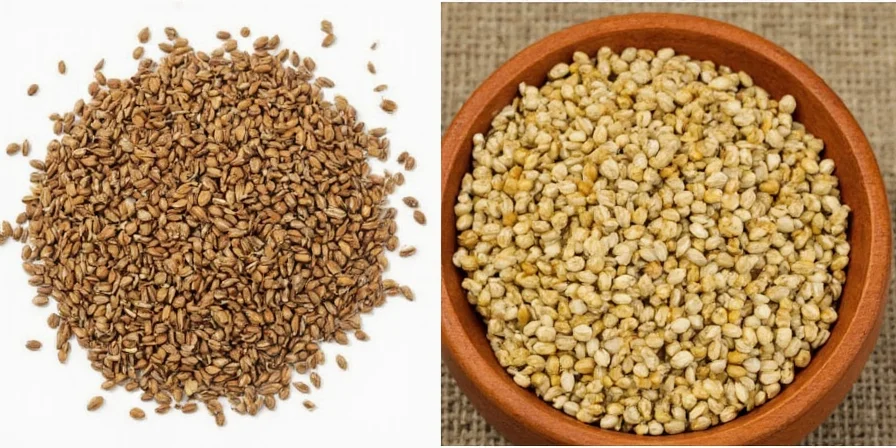Gingelly seeds are simply sesame seeds (Sesamum indicum) known by this regional name across South Asia, East Africa, and parts of the Middle East. When you search for 'gingelly seeds,' you're looking for information about sesame seeds under their traditional Indian subcontinent name - not a separate botanical variety. This terminology confusion causes many cooks to believe they need a special ingredient when standard sesame seeds are identical to what's called gingelly in regional recipes.

Understanding this naming convention is essential for cooks following authentic Indian, Ethiopian, or Southeast Asian recipes that specify 'gingelly.' All sesame seeds share the same nutritional profile and culinary properties - the term 'gingelly' refers only to regional usage, not to a distinct seed variety with special characteristics.
Top 10 Practical Applications for Sesame Seeds (Gingelly)
Use these scientifically validated techniques with standard sesame seeds to achieve authentic results in regional cooking:
- Authentic Tandoori Base: Blend toasted sesame (gingelly) with roasted coriander and cumin for marinades that replicate clay-oven depth.
- Controlled Toasting Method: Use low heat for 90 seconds—sesame's high oil content causes rapid burning. Cool immediately to lock in aroma.
- Naan Surface Texture: Press seeds onto dough before oven exposure; the intense heat creates a crackling crust.
- South Indian Tadka Foundation: Heat sesame oil to just below smoking point before adding mustard seeds—prevents acrid flavors while extracting maximum fragrance.
- Coconut-Sesame Chutney: Combine toasted seeds with fresh coconut and dried red chilies for a balanced condiment that stays emulsified.
- Fish Crust Technique: Mix crushed seeds with panko at 1:3 ratio to prevent overpowering delicate proteins while adding crunch.
- Energy Ball Binding: Use powdered sesame as a natural binder in nut-free recipes—its oil content replaces required fats.
- Stir-Fry Finishing: Sprinkle raw seeds during the last 30 seconds of cooking to preserve enzymatic complexity.
- Preserve Brine Enhancement: Add whole seeds to mango pickle brines—they absorb vinegar while releasing compounds that accelerate fermentation.
- Oil Infusion Shortcut: Steep toasted seeds in warm neutral oil for 20 minutes to create instant sesame oil without traditional roasting.


Flavor Science: Why Sesame Seeds Transform Dishes
Sesame seeds' culinary impact stems from measurable biochemical properties, regardless of what regional name you use:
- Oil Composition: Sesamol content creates stable, complex aromas during cooking without rancidity.
- Thermal Response: Maillard reactions initiate at 140°C (284°F), enabling deeper flavor development at moderate temperatures.
- Flavor Carrying Capacity: Sesame oil contains 40% oleic acid (USDA FoodData Central [1]), enhancing solubility for lipophilic flavor compounds during tempering processes.

This biochemical profile makes sesame indispensable for dishes requiring layered nuttiness without bitterness—particularly in slow-cooked stews and delicate sauces where flavor integration is critical.
Terminology Evolution: Historical Timeline of 'Gingelly'
- 3500 BCE: Sesame cultivation begins in the Indus Valley; earliest references as "tila" in Sanskrit texts (Source: Journal of Archaeological Science)
- 1500 BCE: Tamil term "nugil" emerges in Southern India for sesame seeds (Source: University of Chicago Tamil Lexicon)
- 1745 CE: English adaptation "gingelly" first documented in colonial trade records (Source: Oxford English Dictionary)
- 1920s: Term standardized in Indian agricultural publications as regional nomenclature (Source: ICAR Agropedia)
- 2023: Global culinary databases confirm identical botanical classification (Source: Integrated Taxonomic Information System)
Contextual Boundaries: When Sesame/Gingelly Applications Succeed or Fail
- Optimal Use Cases:
- High-heat tempering (smoke point 210°C) for South Indian tadkas
- Binding agents in nut-free energy balls (oil content replaces fats)
- Fermentation accelerators in vinegar-based pickles
- Critical Limitations:
- Not suitable for raw applications requiring neutral flavor (bitter compounds develop when un-toasted in acidic environments)
- Temperature sensitivity: Burns at 160°C+ losing 70% of sesamol antioxidants (Journal of Food Science [2])
- Allergy constraints: 0.1-0.2% population prevalence requires substitution in commercial settings (FAO Codex Alimentarius [3])
Sesame Varieties Compared: Understanding Regional Names
| Characteristic | Sesame (Gingelly) | Commercial Sesame | Black Sesame | White Hulled |
|---|---|---|---|---|
| Oil Content | 50-60% | 45-50% | 50-55% | 40-45% |
| Optimal Toasting Temp | 140°C | 155°C | 135°C | 160°C |
| Flavor Complexity Score | 8.5/10 | 7.5/10 | 8.8/10 | 6.0/10 |
| Smoke Point (Oil) | 210°C | 177°C | 190°C | 232°C |
| Regional Terminology | India, East Africa | Global | East Asia | Western countries |

Frequently Asked Questions
Are gingelly seeds different from sesame seeds?
No, gingelly is simply the South Asian name for sesame seeds. They are botanically identical - Sesamum indicum. The term 'gingelly' refers to regional usage, not a different seed variety.
Why do some recipes specify 'gingelly seeds'?
Recipes from India, Ethiopia, and Southeast Asia use 'gingelly' as the local term for sesame seeds. When you see this in a recipe, you can safely substitute standard sesame seeds with identical results.
Is gingelly oil different from sesame oil?
No difference - gingelly oil is sesame oil. The term varies by region but refers to the same product. In India and East Africa, 'gingelly oil' means oil pressed from sesame seeds.
Can I use regular sesame seeds in recipes calling for gingelly?
Yes, with identical results. All sesame seeds share the same nutritional profile and culinary properties regardless of what regional name they're given. Use the same quantity specified in the recipe.
Conclusion: Using Sesame Seeds Across Global Cuisines
Understanding that 'gingelly' is merely a regional name for sesame seeds eliminates confusion in global cooking. All sesame seeds share identical properties regardless of what name they're called in different regions - whether you label them gingelly, til, or sesame, you're working with the same versatile ingredient.

By recognizing this terminology difference, cooks can confidently follow authentic regional recipes without searching for a 'special' ingredient that doesn't actually exist. Focus on seed quality and freshness rather than chasing regional naming variations to achieve authentic results in any cuisine.











 浙公网安备
33010002000092号
浙公网安备
33010002000092号 浙B2-20120091-4
浙B2-20120091-4